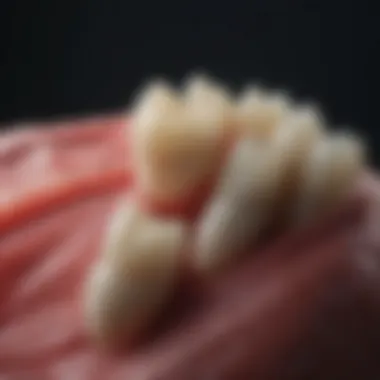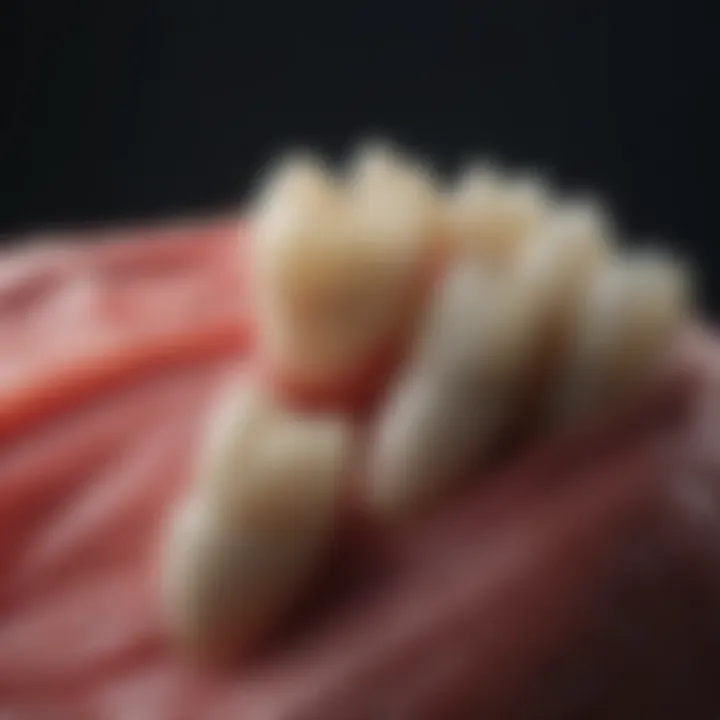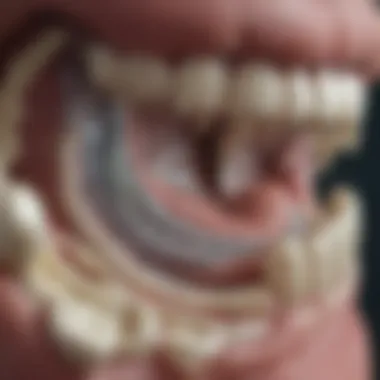Ridge Preservation Grafting: An In-Depth Analysis


Intro
Ridge preservation grafting is a prominent method in dental implantology aimed at maintaining the structural integrity of alveolar bone following tooth extractions. The need for such techniques arises from the biological process of bone resorption, which typically occurs after a tooth is lost. This process can lead to significant challenges for future dental implants and restorative procedures. Therefore, understanding ridge preservation is essential for both practitioners and researchers.
This article offers a detailed exploration of the methods and materials used in ridge preservation grafting, alongside examination of clinical outcomes and biological processes involved. It will highlight effective techniques and the importance of diligent post-operative care. The impact on long-term dental implant success will also be addressed through current literature and case studies.
Methodology
Overview of Research Methods Used
In order to compile a comprehensive analysis of ridge preservation grafting, various research methods have been employed. Clinical studies were assessed for their methodological rigor, focusing on randomized controlled trials and observational studies. Meta-analyses provided insight into the overall effectiveness of different grafting materials and techniques.
Data Collection Techniques
The data collection process incorporated several techniques:
- Literature Review: Existing studies from journals related to dentistry were systematically reviewed.
- Interviews: Discussions with dental professionals familiar with ridge preservation methods were conducted.
- Case Reports: Analysis of specific cases provided practical insight into outcomes and complications.
Through these varied methods, the analysis gathered rich information on ridge preservation practices and their implications.
Biological Mechanisms of Ridge Preservation
Understanding the biological mechanisms behind ridge preservation grafting is key. The primary goal is to encourage new bone formation while minimizing resorption. Grafting materials such as autografts, allografts, and xenografts play disparate roles in this process. Each material is intended to induce bone healing and integration, with different rates of resorption and incorporation into host tissue.
The factors affecting this biological response include:
- Type of Grafting Material: Different graft materials have unique properties that influence the healing process.
- Patient Factors: Age, health status, and oral hygiene of the patient can impact healing.
- Surgical Technique: The precision of the implementation can determine the overall outcome.
"The success of ridge preservation grafting hinges on both biological response and technical execution."
It’s critical to align the choice of material and technique with the specific needs of the patient.
Importance of Post-operative Care
Proper post-operative care is a determinant for the success of ridge preservation grafting. Patients must follow certain protocols to ensure optimal healing. Considerations include:
- Pain Management: Adequate control of pain through prescribed medications.
- Oral Hygiene: Maintaining cleanliness around the surgical site prevents infection or complications.
- Follow-up Visits: Regular assessments by dental professionals enable early identification of problems.
Overall, patients who adhere to post-operative guidelines are more likely to experience favorable results.
Future Directions
Upcoming Trends in Research
With the increasing interest in ridge preservation techniques, upcoming research is focusing on novel materials and methods. Innovations in biomaterials, including bioactive and biodegradable options, may revolutionize practice. Additionally, the use of growth factors and stem cells is being explored to enhance healing.
Areas Requiring Further Investigation
While there is a considerable amount of existing literature, certain areas still require additional research. Long-term follow-up studies on various graft materials are necessary to determine their efficacy. Moreover, the interaction of patient-specific factors and technique variations remains under-studied.
Foreword to Ridge Preservation Grafting
Ridge preservation grafting has emerged as an essential procedure within dental implantology. This technique is implemented to address the loss of alveolar bone following tooth extraction. Understanding ridge preservation grafting is crucial for both practitioners and patients as it significantly influences the success of future dental implants. The main goal of this method is to prevent the collapse of the surrounding bone architecture, which can happen relatively quickly after a tooth is lost.
Importance of Ridge Preservation Grafting
The importance of this procedure can’t be overstated. Ridge preservation grafting helps maintain the original shape and volume of the dental ridge, providing a stable foundation for subsequent implants. Without this preservation, patients may find themselves facing more complex surgical interventions later on. The advancement of techniques in ridge preservation can lead to enhanced clinical outcomes, increased patient satisfaction, and a more straightforward path to successful implant placement.
Benefits to the Patient
For patients, ridge preservation grafting offers several benefits:
- Improved Aesthetic Outcomes: Preserving bone contours enhances the visual appeal of smiles post-treatment.
- Decreased Treatment Time: By minimizing bone loss, future implant procedures often require less time for healing and recovery.
- Maintenance of Oral Functionality: This procedure contributes to the stability of surrounding teeth, allowing patients to retain normal function for longer periods.
Considerations of Techniques and Materials
The techniques and materials used in ridge preservation are varied. It includes options like autografts, allografts, xenografts, and alloplastic materials. Each material has unique properties, influencing healing timelines and structural integrity post-surgery. Understanding these components leads to more informed decisions during treatment planning.
This section serves as a foundation for discussing the more intricate aspects of ridge preservation grafting, laying the groundwork for a deeper exploration of its methods, outcomes, and relevance in dental practice.
Definition and Purpose
Ridge preservation grafting refers to the surgical placement of grafting materials into the socket of a tooth that has just been extracted. This procedure fills the void left by the tooth, helping to maintain the surrounding bone contours. The purpose of ridge preservation is multifaceted. Primarily, it aims to prevent bone resorption, which typically occurs rapidly after tooth loss. By addressing this issue proactively, dental professionals can optimize conditions for future implant placements.


Historical Context
The practice of ridge preservation grafting is not a new concept. Historical approaches to managing alveolar bone loss can be traced back several decades. Initial techniques focused on simple suturing of the extraction site without regard for bone preservation. However, as understanding of the healing processes improved, so did the methodologies. The 20th century marked significant advancements in material science and surgical techniques, allowing for the development of a variety of grafting options. Today, ridge preservation has become standard practice in the field of implantology, showcasing the evolution of dental surgical techniques.
Importance of Ridge Preservation
Ridge preservation grafting is an essential component within the field of dental implantology. Its significance stems from the ability to sustain the alveolar bone's integrity following tooth loss. By minimizing the resorption of bone tissue, this technique ensures that the foundation for future dental implants remains strong and stable.
Consequences of Bone Loss
When a tooth is lost, the surrounding bone begins to deteriorate. This process can occur quite rapidly, often within the first few months after extraction. The primary consequence of bone loss is the reduction of the bone volume needed for successful implant placement.
Several factors contribute to this issue:
- Altered Aesthetics: Loss of bone can lead to changes in facial structure, causing a sunken appearance.
- Functional Disabilities: Insufficient bone may impair the ability to chew effectively, impacting nutrition and overall health.
- Complicated Implant Placement: The decreased volume of bone makes it challenging to place implants. In some cases, patients may find they are not suitable candidates for immediate implant placement.
- Increased Risk of Complications: As bone diminishes, the likelihood of complications during later implant procedures increases, including the risk of infection or implant failure.
"The significance of ridge preservation lies not just in aesthetics but also in maintaining a viable environment for future dental restorations."
Impact on Dental Implants
The influence of bone loss on dental implants cannot be overstated. A successful implant relies on the ability to osseointegrate, or bond with the bone surrounding it. If too much bone is lost, the implant may not have sufficient support.
Key impacts include:
- Reduced Success Rates: Studies indicate that implants placed in areas where significant bone loss has occurred have higher failure rates. The stability of the implant diminishes when the surrounding bone is compromised.
- Longer Treatment Times: Patients may require extensive grafting procedures to rebuild lost bone, delaying the time it takes to receive the implant.
- Increased Costs: More complex procedures, additional materials, and longer treatment timelines result in higher overall costs for the patient.
In summary, ridge preservation grafting is crucial for maintaining both aesthetic and functional aspects of oral health. Understanding the consequences of bone loss and its impact on dental implants benefits practitioners and patients alike, leading to better planning and outcomes in dental care.
Techniques in Ridge Preservation Grafting
The techniques involved in ridge preservation grafting play an essential role in the maintenance of alveolar bone following tooth extraction. Understanding these techniques is crucial for ensuring successful treatment outcomes and improving the longevity of dental implants. Different methods can be employed, each with specific benefits and considerations that influence the success of the grafting process. This section explores the materials used in grafting and the surgical techniques that can be applied in clinical practice.
Bone Grafting Materials
The selection of appropriate bone grafting materials is paramount in achieving optimal results in ridge preservation. Various materials provide different properties that can influence healing and the integration of the graft into the existing bone.
Autografts
Autografts are bone grafts harvested from the patient's own body, typically taken from intraoral sites. This type of graft is favored for its excellent biocompatibility, as the body recognizes it as its own tissue. The key characteristic of autografts is their inherent osteogenic potential, which means they can contribute actively to bone formation. This makes them a popular choice in ridge preservation.
The unique feature of autografts is that they provide not only structural support but also growth factors essential for bone healing. While they are highly effective, the disadvantage includes the need for an additional surgical site, which can lead to increased morbidity and extended recovery time.
Allografts
Allografts involve the use of bone obtained from a donor, which has been processed and sterilized. This type of graft is beneficial as it eliminates the need for a secondary surgical site, providing a less invasive option. The key characteristic of allografts is the preservation of bone structure, which supports natural bone healing through osteoconduction.
However, a unique feature of allografts is their reliance on the recipient’s biology for bone regeneration. Though effective, they carry a slight risk of disease transmission and might result in a less optimal integration compared to autografts. This factor should be considered in clinical decisions.
Xenografts
Xenografts are derived from animal sources, commonly bovine or porcine. They serve as a scaffold for bone growth and are prepared to ensure biocompatibility. The key characteristic of xenografts is that they are readily available and can provide a consistent supply of material. Their use is beneficial in expanding the options available for clinicians.
The unique feature of xenografts lies in their ability to maintain volume during healing while encouraging infiltration through the recipient’s bone. On the contrary, the disadvantage includes potential immunogenic reactions, as these grafts are not of human origin, which can impede the healing process in some cases.
Alloplasts
Alloplasts consist of synthetic materials that can mimic natural bone. They are designed to promote bone regeneration through osteoconductive properties. The key characteristic of alloplasts is that they can be customized to meet the specific needs of the site, providing flexibility in treatment.
Their unique feature is the ability to avoid the complications associated with the use of animal or human tissues. However, a disadvantage of alloplasts is that they may not provide the same level of bioactivity seen in other graft types, potentially impacting their long-term success in complex cases.
Surgical Techniques
Surgical techniques employed during ridge preservation grafting are critical for the success of the graft. They can affect healing outcomes and determine how well the graft integrates into the surrounding bone.
Flap Procedures
Flap procedures involve making incisions in the soft tissue to access the underlying bone. This technique allows for a clear view of the surgical site and facilitates meticulous graft placement. The key characteristic of flap procedures is their ability to provide direct access to the site, improving precision during surgery.


The unique feature of this method is the ability to reposition soft tissue to cover the graft, which may enhance healing and stability. On the flip side, the disadvantage includes the potential for increased swelling and a longer recovery period, which should be considered when planning the procedure.
Socket Preservation
Socket preservation involves the immediate placement of a graft into the empty tooth socket after extraction. This technique aims to maintain the shape and volume of the alveolar ridge. The key characteristic of socket preservation is its ability to minimize bone resorption, which is crucial for future implant placement.
The unique feature of this technique is the timely intervention that helps maintain the anatomical contours of the ridge. However, a disadvantage is that it may require careful selection of patients and meticulous surgical technique to ensure optimal results.
The choice of grafting material and surgical technique forms the foundation of successful ridge preservation, which is vital for the sustainability of dental implants.
Biological Mechanisms of Ridge Preservation
The biological mechanisms at play in ridge preservation grafting are foundational to the success of this dental procedure. Understanding these mechanisms allows practitioners to apply more effective techniques, ultimately improving patient outcomes. When a tooth is extracted, the jawbone can undergo significant resorption. This loss can, in turn, compromise future implant placement and overall dental structure. Thus, recognizing how biological factors influence healing and bone regeneration can lead to more favorable outcomes.
Osteogenic Activity
Osteogenic activity refers to the process of bone formation. In ridge preservation grafting, promoting osteogenic activity is crucial. There are several components essential for enhancing osteogenesis:
- Cells: Osteoblasts are the primary cells responsible for bone formation. Their proliferation and differentiation are vital during healing after grafting.
- Growth Factors: Molecules like bone morphogenetic proteins (BMPs) play a significant role in stimulating osteoblast activity. Injecting or incorporating these into grafting materials can facilitate the healing process.
- Mechanical Stability: For osteogenic activity to occur efficiently, the graft must be stable and not shift. This stability supports the formation of new bone by providing a conducive environment for cell attachment and growth.
Promoting osteogenic activity can directly impact the quality and quantity of the bone that develops, ensuring better integration with dental implants. Understanding the mechanisms can help in selecting appropriate grafting materials that support these biological processes.
Healing Processes
The healing processes following ridge preservation grafting consist of several phases, all of which are critical in determining the success of the procedure. Each phase has unique characteristics and timelines:
- Hemostasis: Immediately after the grafting procedure, clot formation serves as a temporary scaffold for incoming cells.
- Inflammation: This phase lasts a few days and is marked by the presence of immune cells that help clear debris and prevent infection. The inflammatory response also initiates healing by attracting stem cells and osteoblasts.
- Proliferation: Within a week, the focus shifts to tissue regeneration. New blood vessels form in a process known as angiogenesis, and fibroblasts proliferate, providing the initial framework for new bone formation.
- Maturation: Over time, the newly formed bone undergoes remodeling. This process can take several months and is crucial for achieving the final bone density and strength necessary for future implant procedures.
The complexity of these healing processes showcases the need for careful patient management and monitoring. Ensuring optimal conditions during each phase can lead to improved bone integration and lasting success in ridge preservation grafting.
"By grasping the biological mechanisms underlying ridge preservation, practitioners can tailor their approaches to encourage better outcomes for their patients."
Clinical Considerations
Clinical considerations play a pivotal role in the success of ridge preservation grafting. This section highlights essential aspects such as patient selection, pre-surgical preparation, and post-operative care. Adequate attention to these elements can greatly influence treatment outcomes and minimize complications.
Patient Selection
Choosing the right patients for ridge preservation is crucial. Not all individuals are ideal candidates. Key factors to consider include:
- Medical History: Assessing patient’s overall health is fundamental. Conditions such as diabetes, autoimmune diseases, or significant systemic issues may pose risks for graft acceptance and healing.
- Smoking Status: Smoking inhibits healing and can lead to implant failure. Non-smokers generally have better outcomes.
- Bone Quality: Evaluating the quality and quantity of residual bone helps determine the feasibility of grafting. Insufficient bone may necessitate alternative strategies.
Engaging in thorough discussions with potential patients helps set realistic expectations and ensure their understanding of the procedure and potential risks.
Pre-Surgical Preparation
Effective pre-surgical preparation can lay the groundwork for a successful procedure. It represents a strategic phase that includes:
- Diagnostic Imaging: Utilizing tools like cone beam computed tomography (CBCT) provides a comprehensive view of the bone structure. This information can guide the surgical approach.
- Treatment Planning: Customizing the surgical plan based on imaging and individual patient needs is important. Consider the type of graft, technique, and anesthesia options.
- Patient Education: Informing patients about the procedure, its benefits, and possible complications can lead to better cooperation and reduce anxiety.
Preparing patients mentally and physically enhances their overall experience and promotes smoother recovery.
Post-Operative Care
Once the ridge preservation grafting is completed, post-operative care becomes critical. Proper management during recovery can significantly affect long-term outcomes. Essential components include:
- Pain Management: Prescribing appropriate analgesics helps manage discomfort effectively. Patients should be educated on pain expectations.
- Hygiene Instructions: Emphasizing the importance of oral hygiene is vital. Providing guidelines for gentle cleaning around the surgical site can prevent infections.
- Follow-Up Visits: Regular follow-up appointments allow for monitoring healing progress. Adjustments to care can be made if complications arise.
Maintaining rigorous post-operative care can enhance the success rates of ridge preservation and the subsequent placement of dental implants.
Addressing these clinical considerations is not just about immediate surgical outcomes; they form the cornerstone of a holistic approach to patient care in ridge preservation grafting.
Complications and Risks
Understanding complications and risks associated with ridge preservation grafting is essential for practitioners in dental implantology. Awareness of these factors helps in optimizing patient outcomes and managing unexpected situations effectively. Ridge preservation grafting, while valuable, is not without its challenges. Thus, discussing potential complications provides insight into preventive measures and careful planning needed during the procedure.
Common Complications


Common complications subsequent to ridge preservation grafting include:
- Infection: This is a primary concern in any surgical procedure. An infection can delay healing and compromise the grafted site, which may result in inacceptable outcomes.
- Graft Failure: The graft may not integrate properly with existing bone. Several reasons, such as poor blood supply, can lead to this issue.
- Abscess Formation: Accumulation of pus in the graft area may occur, resulting from an infection, leading to inflammation and pain.
- Nerve Injury: Surgical procedures carry the risk of damaging surrounding nerves, causing numbness or pain in nearby areas.
- Insufficient Bone Volume: In some cases, there may not be enough bone to support the graft, which can complicate future dental implant placement.
Awareness and monitoring of these complications are critical. Early detection can often lead to better management and improved patient outcomes.
Management Strategies
Effective management strategies to address complications during ridge preservation grafting involve:
- Proper Surgical Technique: Adhering to established surgical protocols is crucial. This includes aseptic techniques to minimize the risk of infection.
- Pre-operative Assessment: Thorough assessments to evaluate patient's health, existing conditions, and site specifics should inform the surgical plan. This can significantly lower the occurrences of complications.
- Post-operative Monitoring: Observing and analyzing the healing process can catch signs of complications early. Regular follow-ups allow for timely intervention.
- Antibiotic Prophylaxis: Prescribing antibiotics prior to the procedure can help reduce the risk of infection.
- Patient Education: Informing the patient about signs of infection or other complications raises awareness, leading to faster reporting and intervention.
Proper technique is a vital component in preventing complications. Adequate training and experience significantly impact the procedural outcomes.
Comparative Efficacy of Grafting Techniques
The analysis of grafting techniques is critical for understanding their effectiveness in ridge preservation. Various methods and materials employed in these techniques can significantly affect the outcomes of dental implant procedures. By dissecting the comparative efficacy, practitioners can better assess which techniques will yield optimal results in preserving the alveolar bone following tooth extraction.
When comparing grafting methods, it is essential to consider several factors:
- Material Type: Different materials offer varied resorption rates and integration properties. Autografts, for instance, often provide superior healing due to their osteogenic properties. Conversely, allografts and xenografts may be less favorable due to their biological difference from the recipient site, though they still serve an important role in clinical practice.
- Surgical Technique: The manner in which grafts are placed impacts the healing process. Techniques such as flap procedures and socket preservation demonstrate different success rates. An understanding of surgical approaches can guide clinicians in selecting the most appropriate method for specific cases.
- Patient Factors: Patient biology plays a crucial role in graft success. Factors such as age, health, and individual healing responses must be taken into account when determining the best grafting approach.
Ultimately, an in-depth evaluation not only aids the clinician in decision-making processes but enhances the predictability of outcomes for patients undergoing ridge preservation.
Case Studies Overview
An analysis of case studies offers invaluable insights into the practical applications and results of varying grafting techniques. Through these studies, we observe real-world outcomes that complement theoretical knowledge.
- Study Examples: Research covering different grafting techniques highlights their actual performance. For example, studies may focus on patients receiving autografts compared to those treated with allografts. Tracking healing times, integration rates, and eventual implant success allows for a comparative analysis of effectiveness.
- Patient Testimonials: Collections of narratives from patients undergoing different grafting procedures provide qualitative data. Testimonials may include subjective assessments of pain, recovery time, and satisfaction of final results.
In summary, examining case studies establishes a practical context for the efficacy of grafting techniques, allowing practitioners to draw conclusions based on empirical evidence.
Long-term Outcomes
Understanding the long-term outcomes of ridge preservation techniques is essential for gauging overall efficacy. Longitudinal studies that track patients over extended periods provide a clearer picture of the retention and health of the jawbone following grafting.
- Implant Success Rates: Research indicates that grafting techniques can positively influence implant integration. Successfully preserved bone may offer enhanced support, leading to improved osseointegration and implant longevity.
- Bone Resorption: Monitoring bone density in patients over time reveals the effects of different grafting methods. Effective ridge preservation techniques should demonstrate lower rates of post-operative bone resorption, contributing to sustained jaw structure integrity.
- Functional Performance: Assessing the functional performance of implants over time is equally vital. After years of use, factors such as stability, function, and aesthetics help determine the success of the grafting technique applied.
Future Directions in Ridge Preservation
As dental practices evolve, ridge preservation grafting stands at a pivotal junction of innovation and research. The future directions in ridge preservation are essential for practitioners and patients alike, offering insights into new methodologies and expected outcomes. This section will delve into emerging technologies and ongoing research trends that promise to enhance the efficacy of grafting techniques and improve patient care.
Emerging Technologies
Recent advancements in technology are shaping the landscape of ridge preservation. Notably, the integration of 3D imaging and printing techniques has transformed how clinicians plan and execute grafting procedures. These technologies enable precise mapping of the alveolar ridge, allowing for personalized grafting solutions tailored to individual patient needs.
Key technologies that are gaining traction include:
- Bioprinting: This involves creating grafts using living cells and biomaterials to promote natural healing and integration with existing bone. The aim is to develop scaffolds that mimic the natural bone structure, facilitating better vascularization and cell proliferation.
- Growth Factors: The application of recombinant growth factors, such as platelet-derived growth factor (PDGF), has shown potential in enhancing osteogenesis. Using these factors in grafts can stimulate cellular activity and result in more favorable healing outcomes.
- Regenerative Medicine Techniques:
These include the use of stem cells and tissue engineering approaches. Stem cells can differentiate into bone-forming cells, thus playing a crucial role in enhancing bone regeneration. This development could revolutionize how we approach bone augmentation and preservation.
"Emerging technologies are not just improving the outcomes of ridge preservation but are also reshaping patient expectations regarding recovery and implant success."
Research Trends
The academic landscape surrounding ridge preservation is evolving, with an increasing number of studies focused on optimizing grafting methods and materials. Key research trends are driving the field forward, highlighting the importance of evidence-based approaches in clinical practice.
Several noteworthy research directions include:
- Comparative Studies:
Ongoing research will continue to compare the effectiveness of various grafting materials, such as xenografts and alloplasts, assessing long-term success rates and complications. These studies are crucial for informing clinical decisions and enhancing patient outcomes. - Long-Term Outcome Studies:
There is an increased focus on understanding the long-term effects of different ridge preservation techniques. This research aims to evaluate not just immediate results but also sustainability over time, which is vital for the success of dental implants. - Patient-Centered Approaches:
Future research also emphasizes the importance of patient perspectives and satisfaction. Understanding patient experiences and outcomes can lead to improved protocols and better communication strategies within clinical settings.
The advancing technologies and dynamic research trends in ridge preservation grafting promise a future where dental professionals can achieve more consistent success rates while addressing individual patient needs more effectively.
Epilogue
Ridge preservation grafting plays a pivotal role in the landscape of dental implantology. Its significance cannot be overstated, as it addresses the bone loss that frequently occurs after tooth extraction. By implementing effective ridge preservation techniques, practitioners can improve not only the aesthetic outcomes but also the functional success of dental implants.
Summary of Key Points
- Bone Loss Mitigation: Ridge preservation grafting helps minimize the alveolar bone resorption that can occur after tooth extraction. This is critical in maintaining the bone volume necessary for future implants.
- Grafting Materials: A variety of grafting materials such as autografts, allografts, xenografts, and alloplasts are available. Each has specific advantages and should be selected based on the individual patient’s needs.
- Surgical Techniques: The choice of surgical techniques, including flap procedures and socket preservation methods, greatly influences the outcome of grafting procedures.
- Biological Mechanisms: Understanding the biological mechanisms involved, including osteogenic activity and healing processes, is essential for enhancing graft success.
- Post-Operative Care: Proper post-operative care ensures that the graft integrates well with the existing bone, optimizing the conditions for future implants.
Implications for Practice
The implications of ridge preservation grafting for dental practice are profound. Here are a few key considerations:
- Patient Counseling: Educating patients about the potential of ridge preservation techniques can enhance their overall experience and understanding of the treatment process.
- Customized Treatment Plans: Each patient’s anatomical and clinical conditions are unique. Personalized grafting strategies can ensure a higher success rate.
- Emerging Research: Continuous research into new grafting materials and techniques will help practitioners stay at the forefront of dental implant advancements.







